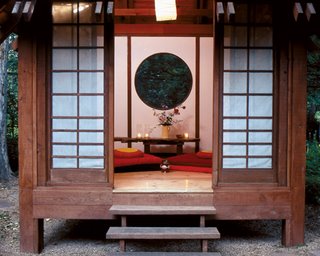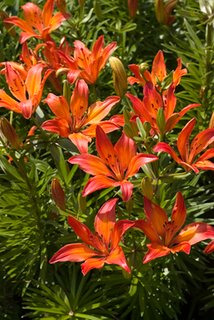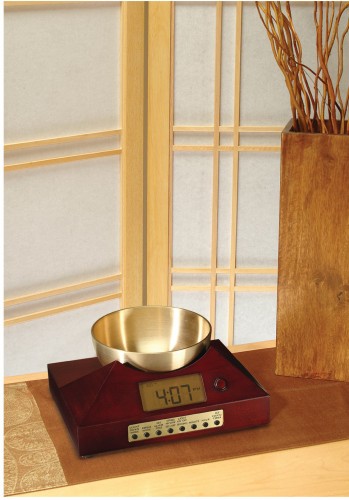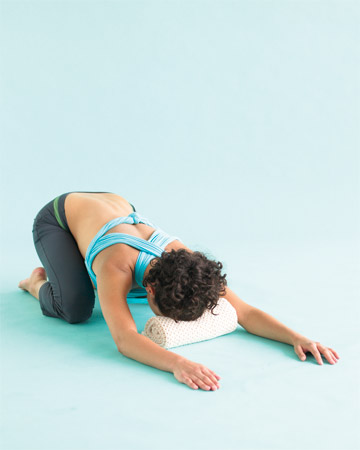|
 Secure Site
Secure Site
|
 |
Archive for the 'Zen Timers' Category
 Savasana Pose - mindfulness practice Savasana, (corpse pose) is a relaxing posture that is intended to rejuvenate the body, mind and spirit. It is recommended that you set aside 20 minutes every day for Savasana , the most restful of the yoga positions. Here are some tips to get you started:
1. Set your meditation timer for 20 minutes so you don’t have to watch the clock. Use the Bamboo Zen Timer by Now & Zen with a calming chime. 2. Lie down on your back on a soft yet firm surface, such as a rug (but not a bed). Place a rolled pillow or blanket under your knees if that feels good, and cover your eyes with a soft cloth. Cover yourself with a light blanket.
3. Let your arms and legs roll slightly out from the body as you relax and begin to take a series of long, slow breaths, setting an intention to disengage from the external world. If your mind starts spinning away, simply return your attention to the breath.
4. When the meditation timer chimes, bend your knees, roll to the side, and sit up. After a moment or two of stillness, reengage with your day.
5. Repeat this every day. Savasana is a good way to reduce stress in your life and give you extra energy for the rest of your day.
 meditation timers with chime
Now & Zen
1638 Pearl Street
Boulder, CO 80302
(800) 779-6383
Posted in Meditation Timers, Meditation Tools, mindfulness practice, Well-being, yoga, Yoga Timer, Yoga Timers by Now & Zen, Zen Timers
 meditation can be done anywhere and anytime Meditation: Sensuousness of Breath
Time: 5 to 10 minutes.
When and Where: Anytime, anywhere.
Position: Sitting comfortably or lying down, eyes open or closed.
Intention: I bask in healing pleasure. I receive the nourishment into every cell of my body.
One of the most universal meditation practices is to take pleasure in the flow and rhythm of breath. Buddha described this as “breathing in and out sensitive to rapture.”
1. Set your Meditation Timer for 5 minutes. Breathe out with a deep sigh a few times and notice what that feels like. Let yourself make quiet whooshing sounds. If you feel a stretch or a yawn coming on, give in to it. Gently ask yourself, “What pleasure do I feel in breathing?”
2. Explore the sensations that accompany breathing — the feeling of the chest expanding and contracting, the gentle touch of the air gliding through the nose and down the throat, filling and then emptying the lungs. How luscious can you let breathing be? Perhaps you enjoy the relaxing ebb and flow of the breath, or love breathing’s whispering sounds. If you’re outside, you might savor the fragrance of grass, trees, or flowers as you inhale. You might feel simple wonder at receiving this essential gift from life.
3. Breathe with this type of awareness for 10 minutes or so, allowing your attention to be soft and undemanding, like rose petals on your skin. Thoughts and feelings about your life will come into your awareness; this is healthy and healing, so don’t try to block them out. Just keep coming back, gently, to the sensuousness of breath when you can.
adapted from Body + Soul Magazine, June 2005 by Lorin Roche and Camille Maurine
Use our unique “Zen Clock” which functions as a Yoga & Meditation Timer. It features a long-resonating acoustic chime that brings your meditation or yoga session to a gradual close, preserving the environment of stillness while also acting as an effective time signal. Our Yoga Timer & Clock can be programmed to chime at the end of the meditation or yoga session or periodically throughout the session as a kind of sonic yantra. The beauty and functionality of the Zen Clock/Timer makes it a meditation tool that can actually help you “make time” for meditation in your life. Bring yourself back to balance.
 meditation timer with chime Now & Zen – The Zen Timer & Alarm Clock Store
1638 Pearl Street
Boulder, CO 80302
(800) 779-6383
Posted in intention, Meditation Timers, Meditation Tools, Well-being, Zen Timers
 a walking practice You know that a brisk walk around the block can clear your head. But it can do even more. Walking rivals yoga, meditation, and tai chi as a powerful mindfulness practice, says Danny Dreyer, a running coach, ultramarathoner, and creator of the ChiRunning and ChiWalking programs. Dreyer has spent years teaching people how to use walking to relieve physical and mental stress by moving in a relaxed way and focusing on physical sensations.
In the following exercise, Dreyer shows how to elevate a simple walk to a meditation in motion, just by using breath and awareness to target tension and trigger the body’s relaxation response. Try this simple stress reliever before an important meeting, after a workday, or any time you need to recapture a calmer, more centered state of mind.
Find a Quiet Place
Choose to walk somewhere soothing — around a lake instead of along a busy road, for instance.
Tip: Don’t rush. Your goal here is to unwind, not to break a sweat or clock in miles. Do your best to maintain an easy gait.
Go Easy
Keep your pace comfortable (as if you don’t need to get anywhere fast) and your stride short.
Breathe Away Tension
Start with your head and observe any tension you might be feeling there. Take a deep inhale, and then with each exhale, imagine releasing tightness in your head and neck. Continue with your shoulders, arms, chest, belly, glutes, upper legs, lower legs, and feet. Spend several breaths on each area, gradually inviting every part of your body to relax. Repeat this exercise.
Take Time to Unwind
Walk for at least 15 minutes, or longer if you have time.
Tip: Focus on tension hot spots throughout your body; this will help you open up and unwind.
adapted from Body + Soul Magazine, September 2007 by Kate Hanley
 Dark Oak Zen Alarm Clock with Chime, a Meditation Timer
Now & Zen
1638 Pearl Street
Boulder, CO 80302
(800) 779-6383
Posted in Chime Alarm Clocks, intention, Meditation Timers, Meditation Tools, mindfulness practice, Now & Zen Alarm Clocks, Well-being, Zen Timepiece by Now & Zen, Zen Timers
 mindful walking Whether you’re staring at a blank page or stuck on a problem, a walk may be just the thing you need to bust through a roadblock. It can even set the stage for inspired thinking and major mental breakthroughs, says Thom Hartmann, author of “Walking Your Blues Away,” by giving you access to the full range of your thought power. “When we walk, we stimulate portions of the brain in the right and left hemispheres, giving us access to more areas of our brains than when we’re sitting still,” he explains. “A million years of evolution have equipped our bodies to operate in an optimal way when we’re walking,” he says. “It’s part of our body’s normal restorative process.” Here are his guidelines for using your daily walk to get out of a mental rut and lure your creativity out into the open.
Skip the Distractions
Wear comfortable clothing, don’t carry anything, and leave the iPod at home. This helps you stay open and balanced so you can focus.
Set a Comfortable Pace
Walk at your normal pace, which helps you sync to your body’s other rhythmic processes, such as heartbeat and breathing rate, which further creates the conditions for insight to occur.
Visualize Your Dilemma
As you’re walking, call up the issue or idea you need clarity on. It can be as richly detailed as a mental image (seeing the finished letter, signed and sealed) or as simple as a question (“What should I say to this person?”). Your mind will inevitably wander; let it. Then, gently guide your thoughts back. Hartmann explains that this interplay between conscious thinking (going over the main points in your mind) and unconscious thinking (daydreaming) brings your whole brain into play and opens you up to inspiration.
Take Your Time
According to Hartmann, the average length of time people require to have a burst in creativity is 15 minutes, or about a mile of walking.
adapted from Body + Soul Magazine, September 2007 by Katie Hanley
 Digital Zen Alarm Clocks, meditation timers and alarm clocks with chimes
Now & Zen
1638 Pearl Street
Boulder, CO 80302
(800) 779-6383
Posted in Chime Alarm Clocks, intention, mindfulness practice, Now & Zen Alarm Clocks, Well-being, Zen Timers
 meditation in motion, walking mindfulness practice Attention, multitaskers: Want to exercise and meditate at the same time? Try Breathwalk, a form of walking meditation that incorporates pranayama and mantra techniques from the Kundalini Yoga tradition. The late Yogi Bhajan introduced this practice to the West in the early 1970s. Since then, yoga students of all shapes and sizes have used it to improve their cardiovascular health, tone their nervous system, boost their energy, stabilize their moods, quiet mental chatter, and embrace the present moment. In its full form, Breathwalk is a five-step process that can take up to 60 minutes; here’s an abbreviated routine you can do in less than 20. Try it in a meadow, on the beach, in the woods, or, if you’re feeling adventurous, on a city street.
The Practice
Begin walking at a normal pace, observing your bodily sensations. Then tune into your breath. Are you breathing with your chest muscles or with your diaphragm? Is your breath shallow and erratic or smooth and deep? Noisy or quiet? Through your mouth or through your nostrils? Gradually refine your breath so that it becomes nasal, diaphragmatic, and free of noise and irregularities.
Now coordinate your breath with your stride, inhaling for four steps and exhaling for four steps. When this feels comfortable and automatic, begin to practice the following breathing pattern: Keeping your nasal passages and facial muscles relaxed, take four short staccato puffs of air through the nostrils—one puff for each step. (Your breath will be audible now; focus on the sound.) Essentially, you are dividing your inhalation into four segments that are synchronized with four consecutive steps. After the first puff, your lungs should be about one-quarter full; after the second, two-quarters full; after the third, three-quarters full; and after the fourth, four-quarters full.
 zen stones Without pausing, exhale in the same fashion, contracting the abdominal muscles and pushing the navel to the spine for four steps (and four segments of the out-breath), so that the final puff pushes the last quarter of air out of your lungs. Continue this pattern for five minutes, then walk and breathe normally for three minutes. As Gurucharan Singh Khalsa, senior student of Yogi Bhajan and co-author of Breathwalk, says, “It’s not about, ‘How far did I walk, how many calories did I burn, how much effort was expended?’ It’s about synchronizing the body, breath, and mind to the present moment, about experiencing a profound sense of connection with yourself and nature.”
Now, repeat the eight-minute practice. This time, as you synchronize your segmented breath with your stride, mentally say the mantra sa ta na ma—one sound for each step and each segmented breath. Repeat the mantra in coordination with the quartered breath for five minutes, then walk and breathe normally for another three.
“Practice for three days in a row and you’ll feel the energizing, focusing effects immediately,” Khalsa says. “If you do it for 40 days you can get really intimate with the technique. You can slip it into the cracks of your day to support you—that’s its purpose.”
adapted from Yoga International, by Shannon Sexton
 Tibetan Meditation Timer with Brass Singing Bowl Now & Zen
1638 Pearl Street
Boulder, CO 80302
(800) 779-6383
Posted in Bamboo Chime Clocks, Meditation Timers, Meditation Tools, mindfulness practice, Now & Zen Alarm Clocks, Zen Timepiece by Now & Zen, Zen Timers
 Silk Lavender Eye Pillows Creating Eye Pillows:
Summer holidays are perfect times for craft projects. Here’s one you can do in an hour and use right away. Eye pillows are handy for traveling and for relaxing in Savasana.
Materials You’ll Need (makes one eye pillow)
For the pillow
1/2 yard of fabric that has been washed, dried, and ironed
For the filling
1/2 cup dried beans or flax seeds
1/2 cup dried rice, lentils, or buckwheat
1/2 cup dried lavender or chamomile
When selecting the filling consider the recipient’s scent preferences and any potential allergies. Mix together three or all of the above items. You’ll need 1 1/2 cups total.
 creating beautiful eye pillows Make the Pillow
Step 1 Cut the fabric
Using a ruler and pencil, mark two 4 1/2-by-10-inch rectangles on the wrong (nonprinted) side of the fabric. With a pair of scissors, cut along the marks to create the two panels needed for the pillow.
Step 2 Sew the seams
Place the two panels’ right (printed) sides together, with the raw edges aligned. Stitch a 1/2-inch seam around the raw edges, backstitching (sewing first in reverse, then forward over the same stitches) at each end. Leave one of the 4-inch sides open, so you can later add the filling. Stitch a 3/8-inch reinforcement seam around the raw edges, leaving the same 4-inch opening. This reinforcement will ensure that the mixture doesn’t leak out of the pillow after you’ve filled it.
With your scissors, cut two 1/4-inch notches in each seam allowance (the area between the stitching and the raw, cut edge of the fabric), one on either side of each of the four corners, making sure not to clip the stitching. Turn the eye pillow right side out for the next step.
Step 3 Fill the pillow
Spoon 1 1/2 cups of filling into the pillow’s open seam.
Step 4 Close the final seam
Fold each side of the remaining 4-inch seam 1/2 inch toward the inside of the pillow, and pin the opening closed. Either by hand or with a sewing machine, stitch a seam across the folded edges to close the 4-inch opening, then try out the pillow: Set your Zen Meditation Timer to 5 minutes, lie down, put it over your eyes, and treat yourself to 5 minutes of deep relaxation.
adapted from Yoga Journal, by Victoria Everman
 Zen Mediation Timers Now & Zen
1638 Pearl Street
Boulder, CO 80302
(800) 779-6383
Posted in Chime Alarm Clocks, Meditation Timers, Meditation Tools, mindfulness practice, Now & Zen Alarm Clocks, Well-being, Zen Timers
Kyoto meets Giverny in this artful garden, a sublime space for contemplation.
 teahouse, photo by Povy Kendal Atchison Japanese shoji screens traditionally are made from translucent rice paper, but the owners chose a durable, light-penetrating fabric that will prevail in harsh weather. It allows filtered light without sacrificing privacy. The floor is salvaged pine planks from a park ranger’s mountain cabin, and a round window brings in the garden even when the doors are closed.
Ten years ago, a Boulder, Colorado, couple bought a house on a patch of grass with some overgrown shrubs, sliced by an irrigation ditch. Where many people might have seen desolation, these intrepid gardeners saw the opportunity to create a private world of solitude and renewal. In the process, they discovered that designing and planting is as soothing as enjoying the completed garden.
The contemplative garden they’ve created gently nods to Asian style while embracing European impressionism. It borrows from 19th-century impressionist painter Claude Monet, as well as from the Japanese love of plant textures, weeping trees and artfully placed rocks. It includes water, rocks, expanses of greenery and winding paths, but not the formal Japanese plantings that require so much upkeep.
Monet’s famous garden in Giverny, France, includes a Japanese bridge over a water lily pond. In this Colorado garden, a pale-aqua bridge arches over an irrigation ditch that’s been funneling water to farmers for 100 years. Just as the lily pad pond became the Monet garden’s major draw, the ditch has been transformed—lined with sandstone rocks alongside a bed of river rocks. Gold, yellow and orange daylilies drape the bank, blooming in midsummer when the Siberian and Japanese irises offer only seed pods. Ornamental grasses bend and sway to the breeze stirred up by the water’s flow. The ditch is an enticement; visitors brace against the railing and peer into the water, watching blossoms float downstream.
Every corner of this garden was designed with careful thought, not lavish funds. A decade of hard work and trial-and-error provided an education.
Piecing together elegance
Every corner of this garden was designed with careful thought, not lavish funds. A decade of hard work and trial-and-error provided an education. In hindsight, the homeowners believe their decision to tackle their garden in small pieces rather than taking on the entire half-acre saved them time, money and frustration.
“We didn’t have a grand master plan,” one of the homeowners admits. Instead, he started by clearing dead and dying trees. Then he parceled the property into smaller gardens: a ditch lined with water-loving plants and flagstones circles the edges of the gardens and is sprinkled with elfin thyme and other herbs for groundcover.
To imitate nature’s undulating, uneven landscape, he built mounds, or berms, from garden soil, adding interest to the flat piece of land. Berms also provide quick drainage for plants that might never take hold without humus and gravel. Sun-loving plants such as foxtail lilies and peonies are located on the sunny mounds. Shade-loving hostas line the flagstone walkways under giant locust trees.
“It all came together like a jigsaw puzzle,” the gardener says, with groundcovers of thyme and vinca, creeping veronica, wild strawberries and sweet woodruff. Groundcovers that can become invasive thugs, such as the sweet woodruff, were banished to the riverbank under the house, where it can duke it out with ornamental strawberries for space and light.
What’s in this garden?
• Crabapple trees (Malus spp), highly adaptable to most weather and soil conditions, have exquisite spring blooms. The weeping varieties include Red Jade, Coral Cascade, White Cascade and Louisa. Best to order from your local garden center.
• Species (or wild) tulips (Tulipa spp) have brilliant hues and hardiness. Long before more formal tulips became the backbone of Dutch gardens, miniature species tulips blanketed hillsides in Turkey. Most only can be grown in climates with winter temperatures. Order from trustworthy companies (see “Resources,” below) that propagate their own bulbs and do not harvest from the wild.
• Foxtail lilies (Eremurus spp) have attention-grabbing feathery spikes and day-glow colors. They’re easy to grow, but they do require good drainage to avoid root rot.
• Thyme (Thymus spp) may be slow to start, but once established, it tolerates some foot traffic. Best as filler between stepping stones, aromatic thymes will creep around rocks and steps, choking out weeds.
• Daylilies (Hemerocallis spp) have sweeping, grasslike foliage and arching blooms. Each blossom lasts only one day, but the plant blooms nonstop throughout summer. They require little care aside from division every few years, and only a moderate amount of water.
 daylilies • Irises (Iris spp) are easy to grow if you choose the right cultivars for your garden. Siberian and Japanese irises grow best in moist, slightly acid soil, perhaps on the banks of a pond or stream. For alkaline soil and aridity, choose bearded irises. And if you love variegated leaves of white and green, look into Iris pallida.
• Hostas (Funkia spp), with wide, variegated leaves, add to foliage interest rather than floral displays. Lords of the shade garden, hostas can be found in a variety of sizes, some with blue-tinged or gold coloration and heart-shape leaves. All need some moisture and dappled shade.
Four seasons of splendor
In this garden, bold plants such as peonies and foxtail lilies are the prima donnas—showy and extravagant with heavy blooms. Other beauties are far smaller and require a closer look. Brilliant red and yellow species tulips—more natural looking than their formal, hybrid cousins—pop up among drifts of thyme. Delphiniums and their smaller brethren, larkspur, join foxgloves for height and extravagant color. Oriental poppies and California poppies display papery petals, popping up in mounds and drifts.
 oriental poppy In early spring, the bright blues and purples of the groundcovers cluster throughout the garden, complementing the species tulips’ tiny blooms. By late spring, foxgloves and Siberian and Japanese irises dominate. Summer is golden, as daylilies offer orange, yellow and cream colors.
The garden may be at its best in winter, the gardeners claim. Japanese lanterns guide visitors down the flagstone footpath, and snow sets a black-and-white scene. Bare, weeping crabapple branches bend gracefully like sculpture. “Some of the most beautiful times in the garden are in the snow,” the homeowner says. “You see all the shapes that don’t go away: the mounds, rocks, ornaments, trellises.”
Reflecting in the teahouse
Autumn and winter usher in the garden’s quiet moments, when trowels are put away. A tiny teahouse, built of salvaged cedar siding left over after the house was built, holds sway. Once inside, a cup of hot tea banishes the cold. Sliding shoji screen doors open to the sparkling light on snow or close to keep out a brisk wind. The nine-by-nine-foot teahouse anchors this garden, a reminder that its primary purpose is to promote meditation and reflection rather than busyness. A Zen Timepiece adornes the interior so that one can timer their meditation practice. The naked branches of an old cottonwood tree loom over the teahouse while smaller pines and dwarf evergreens screen the street and neighborhood. “The teahouse gave us a focus for the garden,” the homeowner says, “and cut down the amount of lawn.”
In winter’s stillness, when birds are silent, only the bamboo wind chimes clink softly. The teahouse’s back wall features a round window that provides the most private views and connects the garden to the teahouse. “I wanted a big round window,” the owner says, “to bring the outside in.”
 Zen Timepiece with brass singing bowl, a meditation timer. adapted from Natural Home Magazine, March/April 2008 by Niki Hayden
Now & Zen
1638 Pearl Street
Boulder, CO 80302
(800) 779-6383
Posted in Bamboo Chime Clocks, Chime Alarm Clocks, Japanese Inspired Zen Clocks, Now & Zen Alarm Clocks, teahouse, Well-being, Zen Timepiece by Now & Zen, Zen Timers
 yoga, loosen up pose Saturday: Loosen Up
The sun’s out and the day’s wide open. Savor your Saturday by twisting away any residual tension in your back. It’s a delicious way to wake up — or even wind down after running around town.
Supported Reclined Twist
What It Does
Helps the whole body (hips, spine, digestive system, nervous system, shoulders, chest, etc.) unwind. Promotes digestion and detoxification.
How to Do It
Set your Zen Yoga Timer to gong after 5 minutes. Lie on your back, dropping your left knee across your body to rest on a pillow or blanket. Shift your hips right to avoid over-twisting the lower back.
Rest your arms, elbows soft, on the floor over your head. Turn your head in whichever direction feels most comfortable and breathe into this gentle stretch for 5 minutes on each side, until the gong chimes.
adapted from Body + Soul, 2010
 Zen Yoga Timepiece in Maple Now & Zen
1638 Pearl Street
Boulder, CO 80302
(800) 779-6383
Posted in Chime Alarm Clocks, Japanese Inspired Zen Clocks, Well-being, Yoga Timer, Yoga Timers by Now & Zen, Zen Timepiece by Now & Zen, Zen Timers
 yoga, sooth frazzled nerves pose Friday: Soothe Frazzled Nerves
As another hectic workweek slows to a close, it’s time to downshift — and ramp up your self-care.
Friday’s pose quiets your mind and nervous system, restoring your inner resources so that you can fully enjoy the weekend ahead.
Supported Child’s Pose
What It Does
Releases the muscles in the back, gently opens the hips, boosts your energy.
How to Do It
Set your Zen Timepiece to gong after 5 minutes. Sit back on your heels with your legs folded under you and the tops of your feet on the floor. Open the knees wide and bend forward at the hips.
Rest your forehead (or your chest) on a pillow or blanket and keep your arms slightly bent. If your buttocks don’t reach your heels, place a blanket under your thighs. Relax and breathe deeply for 5 minutes, until your Zen Yoga Timer gongs.
adapted from Body + Soul, 2010
 Zen Timepiece with brass singing bowl, a yoga timer
Now & Zen
1638 Pearl Street
Boulder, CO 80302
(800) 779-6383
Posted in Bamboo Chime Clocks, Chime Alarm Clocks, Japanese Inspired Zen Clocks, Meditation Timers, Meditation Tools, Now & Zen Alarm Clocks, Well-being, Yoga Timer, Yoga Timers by Now & Zen, Zen Timepiece by Now & Zen, Zen Timers
 A shakuhachi flute, traditionally made of bamboo The shakuhachi, is a Japanese end-blown flute. It is traditionally made of bamboo, but versions now exist hardwoods. It was used by the monks of the Fuke of Zen Buddhism in the practice of suizen, blowing meditation).
Suizen is a Zen practice consisting of playing the shakuhachi bamboo flute as a means of attaining self-realization. The monks from the Fuke sect of Zen who practiced suizen were called komusō (“emptiness monks”).
adapted from wikipedia.org
 B Tone Digital Zen Alarm Clock in a Bamboo Finish
Now & Zen
1638 Pearl Street
Boulder, CO 80302
Posted in Bamboo Chime Clocks, Chime Alarm Clocks, Japanese Inspired Zen Clocks, Now & Zen Alarm Clocks, Progressive Awakening, zen monks, Zen Timers
« Previous Page — « Previous Entries
Next Entries » — Next Page »
|
|
|
|